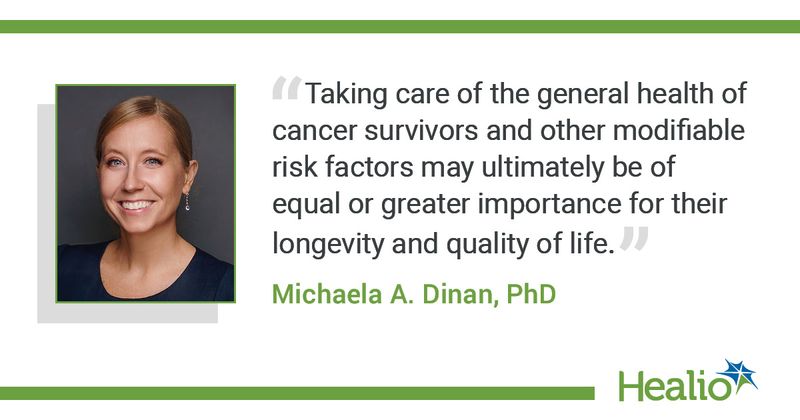Cancer and neoplasms
Certain cancer survivors far more likely to die of noncancer-related causes
July 17, 2023
3 min read
Source/Disclosures
Published by:
Disclosures:
Dinan reports grants from NCI outside the submitted work. Please see the study for all other authors’ relevant financial disclosures.
Key takeaways:
- The relative risk for noncancer-associated mortality appeared high for patients with breast, prostate or colon cancers.
- Heart disease accounted for more than one-fourth of all noncancer-associated deaths.
Long-term survivors of certain early-stage cancers diagnosed after age 65 years appeared at higher risk for mortality due to noncancer causes, according to study results published in JAMA Network Open.
The most common noncancer causes of mortality included heart disease, Alzheimer’s disease, cerebrovascular disease and chronic obstructive pulmonary disease (COPD), researchers noted.
Rationale
The cancer survivor population is growing, with two-thirds of cancer survivors now living more than 5 years, Michaela A. Dinan, PhD, associate professor of epidemiology at Yale School of Public Health and co-leader of the cancer prevention and control research program at Yale Comprehensive Cancer Center at Yale School of Medicine, told Healio.
Moreover, two-thirds of those long-term survivors are aged older than 65 years, Dinan added.
“The complex health needs and higher comorbidity burden of this population requires more follow-up care and greater health surveillance,” she said. “With the growth and aging of the cancer survivor population, the demand for oncology services is outpacing the supply of oncologists.”
With the shifting landscape and higher demand for follow-up care, the current model of care in which oncologists treat comorbid conditions will become increasingly costly at the expense of quality, Dinan continued.
“It is increasingly important that long-term care for cancer survivors is appropriately allocated with increasing coordination between patients, oncology, primary care and other specialty care,” she said.
Methodology
Researchers sought to examine rates of absolute and relative cancer-specific vs. noncancer-specific mortality and the associated risk factors among a cohort of 627,702 long-term cancer survivors (mean age, 61.1 years; 69.3% women; 71.1% white) included in the SEER cancer registry.
All survivors received a diagnosis of breast (n = 364,230), prostate (n = 118,839) or colorectal cancer (n = 144,633) between 2003 and 2014, underwent definitive treatment for localized disease and were alive 5 years after initial cancer diagnosis.
Researchers calculated survival time ratios using accelerated failure time models. Independent variables included age, race and ethnicity, sex, grade and stage, income, residence, ER/PR status, PSA level, and Gleason score.
Mortality from index cancer compared with alternative mortality served as the primary outcome. Secondary outcomes included subgroup mortality among cancer-specific risk groups, categorized based on prognostic factors and proportion of deaths due to cancer-specific vs. noncancer-specific causes.
Findings
Factors associated with shorter median cancer-specific survival included stage III breast cancer (survival time ratio, 0.54; 95% CI, 0.53-0.55), colon cancer (survival time ratio, 0.6; 95% CI, 0.58-0.62) and rectal cancer (survival time ratio, 0.71; 95% CI, 0.69-0.74), as well as a Gleason score of 8 or higher for prostate cancer (survival time ratio, 0.61; 95% CI, 0.58-0.63).
Results additionally showed that all patients with low oncologic risk at time of diagnosis experienced at least threefold higher risk for noncancer-specific mortality compared with cancer-specific mortality at 10 years from diagnosis.
Two-thirds of breast cancer survivors died of noncancer-associated mortality, including heart disease (24%), Alzheimer’s disease (7.1%), cerebrovascular diseases (6.6%) and COPD (6.5%).
Among survivors of prostate cancer, researchers found most deaths (77.9%) had no association with cancer. These included deaths due to heart disease (24.5%), followed by COPD (6.1%), cerebrovascular diseases (4.8%) and Alzheimer’s disease (3.5%).
Researchers additionally found that more than two-thirds of survivors of colorectal cancer died of a noncancer-associated cause, with nearly one-third of deaths associated with heart disease.
Results also showed patients with high oncologic risk at time of diagnosis experienced a higher cumulative incidence for cancer-specific mortality vs. noncancer-specific mortality for all cancer cohorts, except prostate cancer.
Limitations of the study included unavailability of data on patient comorbidities, which therefore could not be examined, according to the researchers.
“Variations in treatment and access to care can be significantly associated with cancer outcomes, particularly in racial and ethnic minority groups that often experience disparities in accessing quality health care services,” they wrote. “Structural racism is likely associated with the disparities in treatment based on race and ethnicity, resulting in limited availability of specialized cancer treatments and support for these groups. However, this study could not assess treatment patterns or access to care due to data limitations.”
Implications
Long-term cancer survivors and their providers need to realize that there is life after cancer, Dinan told Healio.
“Taking care of the general health of cancer survivors and other modifiable risk factors may ultimately be of equal or greater importance for their longevity and quality of life,” she said. “The next step is diving deeper into the specific causes of noncancer deaths for these long-term cancer survivors. If we are better able to understand how to predict which patients are at highest risk for specific events due to either their individual characteristics or treatment exposures they experienced as part of their cancer care, this might help us inform how best to care for these long-term survivors and what kind of preventive care might be most important.”
For more information:
Michaela A. Dinan, PhD, can be reached at michaela.dinan@yale.edu.

